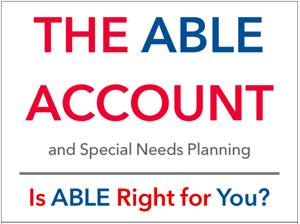Updated June 30, 2021
 Some major changes to the ABLE, first implemented in 2018 are:
Some major changes to the ABLE, first implemented in 2018 are:
- ABLE to Work- additional allowable contributions by the beneficiary as a result of employment.
- Ability to Rollover funds from a 529 College Savings account to an ABLE -529A - account.
- Savers Credit - Access to the Retirement Savings Contribution Credit.
1. ABLE to Work
The ABLE to Work provision was passed by Congress as part of the Tax Cuts and Jobs Act of 2017. It is currently set to expire on January 1, 2026. Gainfully employed people with disabilities, who meet the qualifying requirements, have the opportunity to save and control their own money without fear of jeopardizing benefits.
-
This provision allows an ABLE account beneficiary who works and earns income to contribute funds above the $15,000 annual limit.
-
The additional contribution may be up to the lesser of: the account beneficiary's earned income or the federal poverty line, which for 2021 is $12,880. This means it is possible to contribute up to $27,880 to an ABLE account in one year.
-
Two additional elements of the law to be aware of when considering eligibility for the additional contribution:
-
(1) the ABLE beneficiary may not be a participant in their employer-based retirement fund, including if an employer makes contributions to the fund on their behalf.
-
(2) the Beneficiary's employment earnings deposited in an ABLE account are still counted in terms of Substantial Gainful Activity (SGA) or earned income, and will be taken into consideration when determining eligibility for certain public benefits.
-
Case example:
Sheila, an ABLE owner has a job and made $16,000 in 2020. She does not participate in her employer's retirement plan. Although her parents put $15,000 into her ABLE account in 2020, Sheila was able to contribute an additional $12,880 of her own money into her ABLE account.
2. 529 Fund Rollovers
This provision allows funds in a 529 College Savings account to be rolled over into an ABLE - also known as a 529A account. It is currently set to expire on January 1, 2026.
- The ABLE account beneficiary to receive the rollover funds must be either:
- the beneficiary of the 529 College Savings Account or
- A "family member" of the beneficiary of the 529 College Savings account
- The rollover funds are subject to the annual contribution limit of $15,000 for any given tax year, given that no other contributions have been made into the account that year.
Example: Max, a teenage child just received a diagnosis of autism. When he was born his parents started a college savings fund (529) for him but now it is not known whether he will go to college or not. An ABLE account may be opened for Max, assuming he meets the criteria, and his parents may now roll over the 529 to an ABLE account without any penalties or taxes due on earnings.
3. Saver's Credit- also known as the Retirement Savings Contributions Credit.
The Saver's Credit was designed to provide an incentive for low and middle income individuals to save. It is currently set to expire on January 1, 2026.
An ABLE owner contributing to their own account, and meeting the following eligibility requirements, may claim this credit toward taxes owed with the maximum value reducing the taxes owed to zero. The ABLE owner must be:
- Age 18 or older
- Not a full time student
- Not claimed as a dependent on another person's return
Details about the Saver's Credit:
- Maximum credit is $2000 for an individual and $4000 for a couple
- Percent of your contribution allowed to take is reduced as your AGI ( Adjusted Gross Income) increases
This chart outlines the credit for each category of tax filer:
| 2021 Saver's Credit | |||
| Credit rate |
Married- filing jointly |
Head of Household |
All Other Filers* |
|
50% of your contribution |
AGI less than $39,500 |
AGI less than $29,625 |
AGI less than $19,750 |
|
20% of your contribution |
$39,501- $43,000 |
$29,626 - $32, 250 |
$19,751- $21,500 |
|
10% of your contribution |
$43,001- $66,000 |
$32, 251- $49,500 |
$21,501- $32,500 |
|
0% of your contribution |
More than $66,000 |
More than $49,500 |
More than $33,000 |
Source: https://smartasset.com/taxes/understanding-savers-tax-credit
Example: You are an ABLE owner working and making $20,000. You have put $2000 into your ABLE account this year. You can take a credit of 50% of your contribution, equal to $1000 in this case, to reduce your tax liability. If possible, you can use this $1000 to contribute further to your savings.
For further information, please contact us or visit the ABLE National Resource Center.
Content in this material is for general information only and not intended to provide specific advice or recommendations for any individual, nor intended to be a substitute for specific individualized tax or legal advice. We suggest that you discuss your specific situation with a qualified tax or legal advisor. [ add line space ] Prior to investing in an ABLE account investors should consider whether the investor's or designated beneficiary's home state offers any state tax or other benefits that are only available for investments in such state's ABLE program. Withdrawals used for qualified disability expenses are federally tax free. Tax treatment at the state level may vary. Investing involves risk including loss of principal. No strategy assures success or protects against loss.



